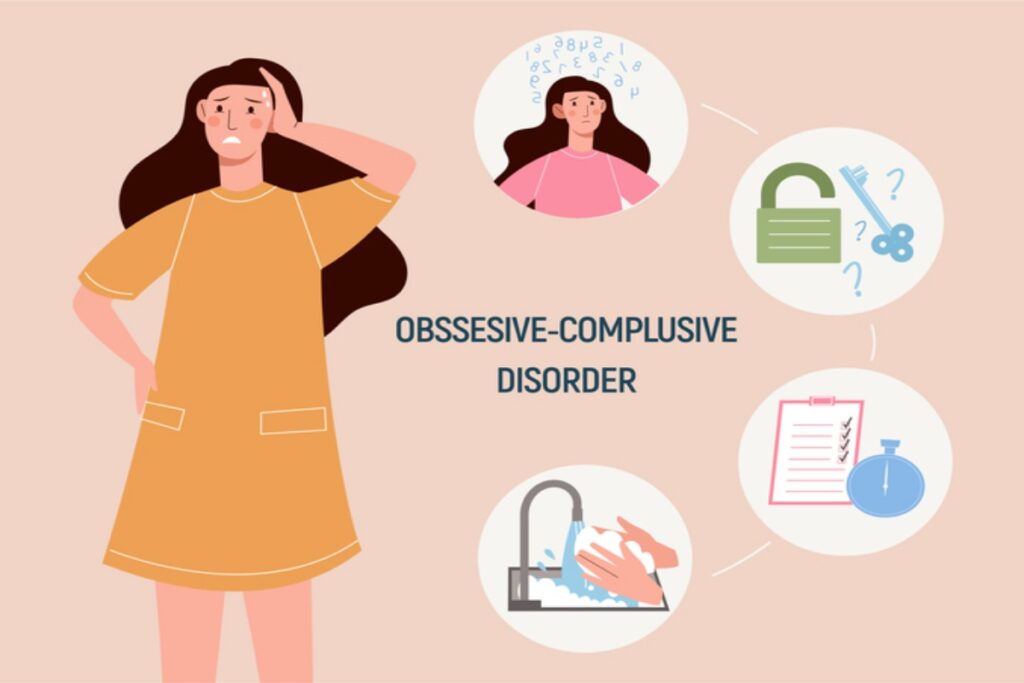Obsessive-compulsive disorder (OCD) is a chronic psychiatric condition characterized by the presence of obsessions—unwanted, intrusive thoughts—and compulsions—repetitive behaviors aimed at reducing distress. These symptoms can significantly impair daily functioning, relationships, and overall quality of life. OCD is categorized as an anxiety-related condition and can manifest in individuals of all ages, with early onset often occurring in childhood or adolescence.

Core Features: Obsessions and Compulsions
Obsessions: Persistent Intrusive Thoughts
Obsessions are distressing thoughts, images, or urges that frequently occur against the individual’s will. They are often irrational and cause significant anxiety.
Common obsessions include:
- Fear of contamination or germs
- Intrusive violent or sexual thoughts
- Excessive doubts (e.g., leaving doors unlocked)
- Need for symmetry or exactness
Compulsions: Repetitive Ritualistic Behaviors
Compulsions are actions performed in response to obsessions, intended to reduce the anxiety they cause. These behaviors are often time-consuming and interfere with normal routines.
Common compulsions include:
- Excessive cleaning or handwashing
- Checking locks or appliances repeatedly
- Counting or repeating words silently
- Arranging objects in a specific way
Types of OCD: Subtypes Based on Symptom Patterns
While OCD symptoms vary widely, they can be categorized into common subtypes for diagnostic clarity and treatment planning:
- Contamination OCD – Fear of germs and contamination, often paired with compulsive washing
- Checking OCD – Repeated checking of locks, appliances, or safety concerns
- Symmetry and Ordering OCD – Obsession with symmetry or exactness; compulsions involve arranging or aligning
- Harm OCD – Fear of harming oneself or others; includes intrusive aggressive thoughts
- Sexual and Religious OCD (Scrupulosity) – Obsessions centered on moral, blasphemous, or taboo thoughts
Causes and Risk Factors
Neurobiological Factors
Evidence suggests that OCD involves dysfunction in the cortico-striato-thalamo-cortical (CSTC) circuit. Neuroimaging studies have shown abnormal activity in:
- Orbitofrontal cortex
- Anterior cingulate cortex
- Basal ganglia (particularly the caudate nucleus)
Imbalances in serotonin and glutamate neurotransmission are also implicated in OCD pathophysiology.
Genetic and Environmental Influences
- Genetic predisposition plays a significant role, with higher rates of OCD among first-degree relatives.
- Perinatal complications, childhood trauma, and streptococcal infections (PANDAS) may act as environmental triggers.
Diagnostic Criteria and Assessment
OCD is classified under the Obsessive-Compulsive and Related Disorders section in the Diagnostic and Statistical Manual of Mental Disorders, Fifth Edition (DSM-5).
Diagnostic Requirements:
- Presence of obsessions, compulsions, or both
- The behaviors are time-consuming (more than 1 hour per day)
- Symptoms cause significant distress or impairment
- Not attributable to another medical condition or substance
Assessment tools include:
- Yale-Brown Obsessive Compulsive Scale (Y-BOCS)
- Structured Clinical Interviews (SCID)
- Obsessive-Compulsive Inventory-Revised (OCI-R)
Evidence-Based Treatment Options
Cognitive Behavioral Therapy (CBT) with Exposure and Response Prevention (ERP)
CBT with ERP is the most effective psychotherapy for OCD. It involves gradual exposure to anxiety-provoking stimuli while preventing the compulsive response.
Benefits of CBT with ERP:
- Reduction in symptom severity
- Long-lasting treatment effects
- Can be delivered in individual or group formats
Pharmacological Treatment
Selective serotonin reuptake inhibitors (SSRIs) are the first-line medications for OCD. They help regulate serotonin levels in the brain and reduce obsessive-compulsive symptoms.
Common SSRIs include:
- Fluoxetine
- Fluvoxamine
- Sertraline
- Paroxetine
- Citalopram (off-label)
Clomipramine, a tricyclic antidepressant, is also effective but has more side effects.
Advanced Interventions for Treatment-Resistant OCD
When standard treatments fail, more advanced interventions may be considered:
- Deep Brain Stimulation (DBS) – Targets the CSTC circuit in severe refractory cases
- Transcranial Magnetic Stimulation (TMS) – A non-invasive brain stimulation technique
- Intensive residential treatment programs – For individuals with severe functional impairment
Prognosis and Long-Term Outlook
The course of OCD varies, with some individuals experiencing chronic symptoms, while others show episodic or partial remission. Early intervention, adherence to treatment, and family support are key to improving long-term outcomes.
Prognostic factors include:
- Early age of onset (usually poorer outcome)
- Co-occurring conditions (e.g., depression, ADHD)
- Insight into the irrationality of symptoms
- Treatment responsiveness
OCD in Children and Adolescents
Pediatric OCD often presents differently, with more magical thinking and family accommodation of compulsions. Diagnosis may be delayed as parents interpret compulsions as habits. Early recognition and CBT can prevent chronic impairment.
Obsessive-Compulsive Disorder vs. Obsessive-Compulsive Personality Disorder (OCPD)
Although the names sound similar, OCD and OCPD are distinct disorders:
| Feature | OCD | OCPD |
|---|---|---|
| Nature of Thoughts | Intrusive, distressing | Rigid, perfectionistic |
| Insight | Often good | Poor; behaviors seen as appropriate |
| Presence of Compulsions | Yes | No |
| Ego-dystonic (undesirable) | Yes | No |
| Treatment | SSRIs + CBT | Psychotherapy focused on behavioral change |
Frequently Asked Questions
Q1: Can OCD go away on its own?
OCD typically does not resolve without treatment. However, symptoms may wax and wane over time. Professional intervention is recommended.
Q2: Is OCD a form of anxiety disorder?
OCD was previously categorized under anxiety disorders but is now classified separately under obsessive-compulsive and related disorders.
Q3: Are people with OCD aware of their condition?
Most individuals have insight into the irrationality of their obsessions, though some may have poor or absent insight.
Q4: What happens if OCD is left untreated?
Untreated OCD can lead to significant social, occupational, and academic impairment, and often coexists with depression or substance use disorders.
Q5: Can OCD be cured completely?
There is no definitive cure, but with therapy and/or medication, many individuals achieve significant symptom control and improved quality of life.
Obsessive-compulsive disorder is a complex and multifaceted mental health condition that requires a nuanced, evidence-based approach for diagnosis and treatment. Through a combination of CBT with ERP, pharmacotherapy, and emerging interventions like TMS and DBS, individuals with OCD can experience meaningful recovery. Continued research and public awareness are essential to reduce stigma, improve early detection, and ensure that effective, individualized care reaches those in need.